Archives: Blog
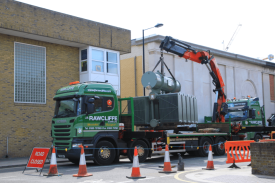
What are HIAB trucks used for and how do they work?
If you’re a company that requires the transportation of heavy goods – whether it’s machinery or construction materials – a HIAB truck could be just the answer you’ve been searching for.
HIAB trucks – also known as HIAB cranes and lorries, or lorry loaders – are powerful machines that can perform a wide range of lifting and transportation tasks. They’re utilised by companies all around the UK daily and are excellent at taking heavy goods from point A to B without strain or stress.
Interested in finding out more about HIAB cranes? Read on to find out what they are and how they work.

What is a HIAB crane?
A HIAB truck is a lorry-mounted crane that can both lift heavy objects and transport them on their bed. HIAB – Hydraliska Industri AB – is a Swedish brand name that’s now synonymous with lorry-mounted cranes thanks to their excellent quality and popularity ever since their beginnings in 1944.
A HIAB lorry is a truck with a fitted crane that lifts, transports and hauls heavy loads with ease.
This unique device, combining the traditional crane with a truck, has transformed haulage tasks across a wide range of industries thanks to its 2-in-1 lift and transport ability.
How does a HIAB lorry work?
A HIAB truck works by lifting heavy goods and loading them onto the bed of the truck to transport them to another location.
A controller will manage the lorry’s crane using a remote control. The HIAB crane can both reach up high to lift goods to an otherwise tricky spot and lift extremely heavy objects.
The vehicle’s engine powers the hydraulics of the crane to grip objects and move them either on or off the truck.
What is a HIAB truck used for?
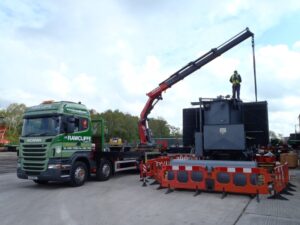
HIAB trucks are used in the heavy haulage industry to assist with the transportation of heavy goods for a wide variety of sectors.
The crane can lift a huge range of objects, including:
- Pallets
- Metal frames
- Construction materials and equipment
- Shipping containers
- Farming equipment
- Vehicles
- Display stands
- Heavy duty pumps
A HIAB crane offers fantastic flexibility to load and unload heavy objects quickly, efficiently and safely without the need for additional equipment, such as forklifts or tail lifts.
This is another major benefit of HIAB trucks as their functionality allows companies to save money on extra vehicles or equipment to help with the loading and unloading of goods.
Do you need a licence for a HIAB crane?
Yes, you need a licence to be able to drive a HIAB truck.
You can complete a course to earn a certification with either The Association of Lorry Loader Manufacturers and Importers (ALLMI) or the National Plant Operators Registration Scheme (NPORS).
A course to become a HIAB truck driver and controller involves learning about the legislation, pre-operational checks, maintenance, preparing the crane for use and, of course, the use of controls.
Once you have successfully completed a course and earned a qualification as a certified lorry loader, you can control a HIAB crane truck.
HIAB truck hire at JB Rawcliffe & Sons
If you require the services of a highly qualified team of heavy haulage experts, check out our HIAB crane hire at JB Rawcliffe & Sons.
We can provide fantastic HIAB truck hire for clients all around the UK thanks to our extensive fleet with lifting capacities to suit every task. No matter your goods, we’ll always have a vehicle available to meet your requirements – even at short notice.
Are you interested in our HIAB truck hire services? If so, don’t hesitate to contact us today. You can get in touch either by calling 01695 737 880 or sending an email to enquiries@jbrawcliffe.com.
A member of our friendly team will be happy to discuss your heavy haulage requirements and go through our HIAB truck options.
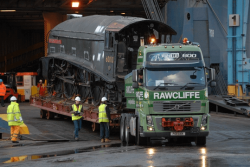
4 Tips for Successful Heavy Haulage in the UK

Moving heavy machinery and equipment across the country can be a tricky and demanding exercise. Heavy haulage in the UK requires a lot of planning, expertise and skill, but when done correctly, it can save a company a lot of money, stress and time.
But, what is heavy haulage and what factors should be considered when planning to transport large goods? Continue reading our guide below to find our four tips for successful heavy haulage.
What is heavy haulage?
Heavy haulage is the term associated with the transportation of large items, such as heavy machinery and equipment, that require specialist vehicles to reach their destination.
The heavy goods are transported from the pick-up location to the desired destination by being loaded onto specially designed heavy haulage vehicles. Typically, heavy haulage transportation is used by companies in construction, agriculture, defence, marine equipment, and oil and gas.
What to consider when transporting heavy haulage

When transporting heavy haulage in the UK – or across Europe – several key factors must be considered to efficiently deliver goods.
In our experience, there are four essential aspects to cover – gathering the right information, choosing the correct equipment, researching point A and point B and planning the route.
Failure to properly plan will result in problems throughout the heavy haulage process. Here are our four tips for ensuring the heavy haulage process is as efficient and safe as possible.
1. Gather as much information as possible
The first step to planning a successful heavy haulage task is to be as informed as possible about the project. This includes the size and weight of the goods, where they’re being picked up from and where they’re being delivered to.
Identifying every detail is the best possible preparation to ensure the efficient pick-up, transport and delivery of heavy goods.
2. Choose the right equipment
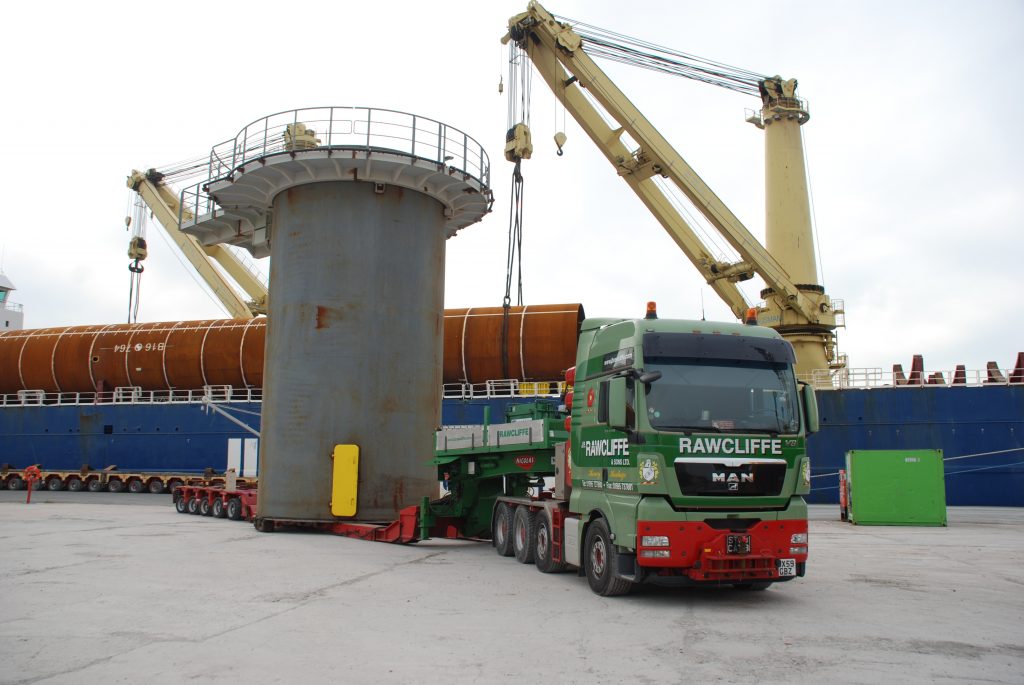
To effectively choose the right heavy haulage equipment, the first step must be done properly.
If all information is collected, including the exact dimensions and weight of the goods, the right equipment can be chosen.
At JB Rawcliffe & Sons, we can offer the following equipment to ensure the safe and efficient delivery of heavy goods:
- Bogies
- Low loaders
- Modular equipment
- Platform trailers
- Prime movers
- Semi-low loaders
- SPMT (self-propelled modular transporters)
If the heavy goods to be transported are classed as an abnormal load (weight of more than 44,000kg, width of more than 2.9 metres, and length of more than 18.65m), planning must be put in place to ensure they arrive safely. This can include using an escort vehicle.
Choosing the right piece of equipment provides the best possible opportunity for successful transport and delivery.
3. Research pick-up and drop-off points
The next step to achieving a successful heavy haulage task is to research the start and end of the journey. Several questions must be answered, including:
- Where is the pick-up location?
- Are there any entry or overhead restrictions?
- Will you need specialist equipment to lift the goods, i.e. forklift truck?
- Where is the drop-off destination?
- What are the ground conditions at both locations?
4. Plan the route
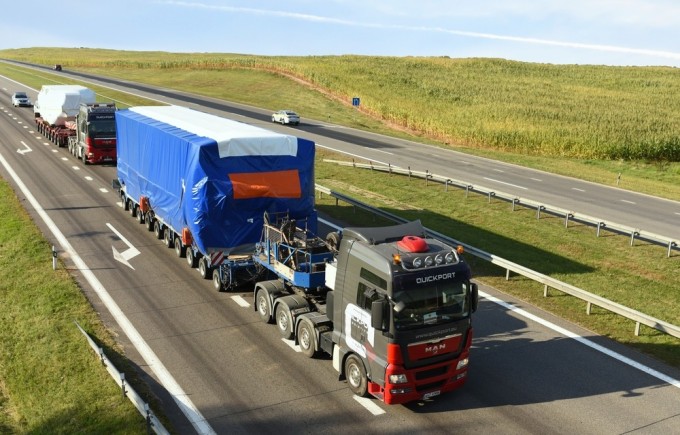
Once all the details of the goods have been collected, the right equipment has been chosen and the drop-off and pick-up locations have been researched, it’s time for the final step.
The route has to be planned correctly to ensure smooth delivery of the goods. Every step of the planning process is important but if the route isn’t researched and planned, the delivery will not go smoothly. This includes things like checking for roadworks, size restrictions on certain roads, toll roads and whether it would be easier to travel during the day or night.
Planning every aspect of the route should also include a plan B and C in case something unforeseen happens with plan A, such as a road traffic accident.
Safety is also paramount, for both the individuals transporting the goods and the goods themselves – and planning is key to ensuring this.
Choose JB Rawcliffe & Sons for your heavy haulage
If you have large goods and heavy machinery that need transporting across the UK or Europe, JB Rawcliffe & Sons are here to get the job done.
We have decades of experience in heavy haulage and have mastered the process now. We meticulously research all aspects of heavy haulage, from the size and weight of the goods to the pick-up and drop-off locations and the route.
We are known for our safety and efficiency and have worked with hundreds of companies, successfully delivering goods of all sizes and weights.
If you require heavy haulage services, don’t hesitate to contact us today. We’re more than happy to discuss your requirements and get the ball rolling.

5 Predictions for Heavy Haulage in 2024
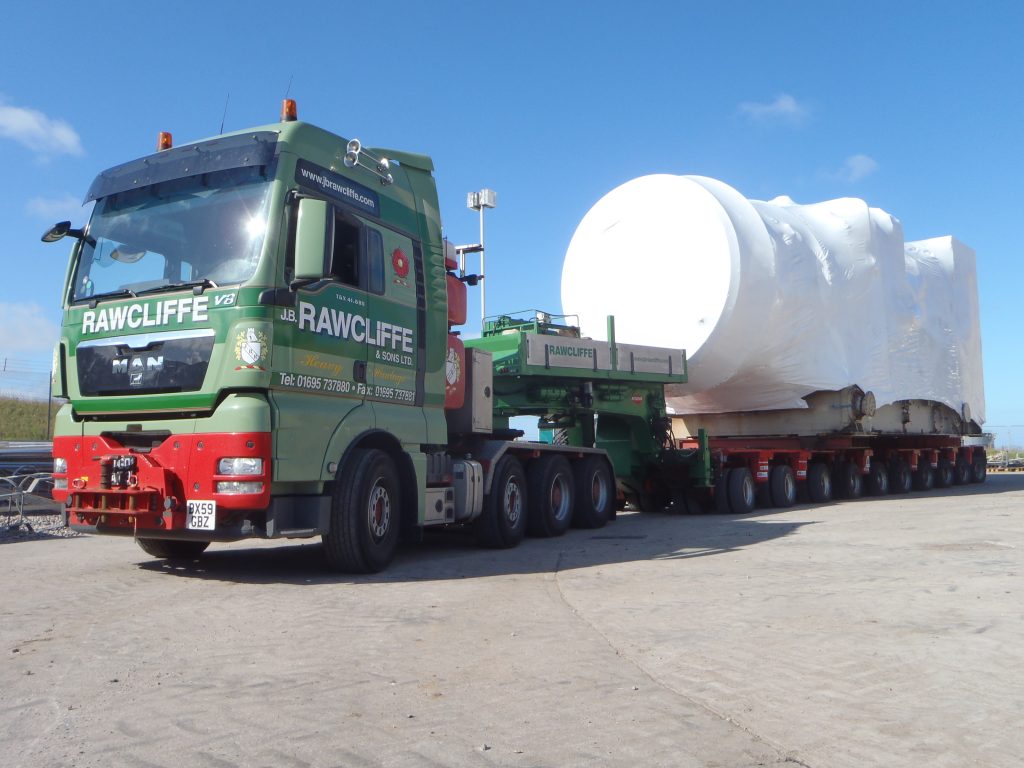
The new year is here and 2024 is sure to be a big one for the UK’s trucking and haulage industry!
There’s a lot of speculation about what trends are going to pop up and what changes are going to be made. With new pressures, technologies and an uncertain financial climate – the transport sector is among one of the many businesses affected by all these changes.
So, what do we think is in store for the heavy haulage industry in 2024? Keep reading to find out…
1.Embracing New Tech
In a sector that was previously hesitant to embrace technology, transport is now fast catching up with other industries – yet there is still some resistance to adopting all these new techs.
The heavy haulage industry has been slowly adopting technology for efficiency and safety.
Some of these new techs include advanced telematics, GPS tracking, and real-time monitoring systems to optimise routes, reduce fuel consumption, and enhance overall fleet management.
2. Cleaner and Greener
Many industries across the UK have been exploring electric and sustainable alternatives to traditional fuel sources that have historically dominated the industry.
We may see a lot more electric trucks and vehicles with alternative fuels on the roads as environmental concerns and regulations continue to shape the industry and current climate.
3. Changes to Regulations
Governments worldwide often introduce new regulations related to emissions, safety standards, and road usage.
With the finalisations of Brexit, cost-of-living crisis and Net-Zero 2050 fast approaching, be sure to stay informed and keep up to date with trends in the heavy haulage industry in 2024.
4. The Future is AI
As much as we would like to avoid it, it’s inevitable that AI (Artificial Intelligence) is slowly infiltrating the four corners of the world.
AI-driven analytics and data-driven insights will be critical in increasing operational efficiencies, traffic management, forecasting demand, and assuring better resource allocation.
In the world of transportation and logistics, things can be uncertain, but companies that are gearing up now are getting ready for the challenges that are sure to come with future growth.
5. Driver Shortages
Finding new drivers from the upcoming workforce generation remains a challenge due to factors like an ageing workforce, a poor industry reputation, a shrinking pool of EU workers, and limited access to apprenticeship funding.
According to Logistics UK, HGV drivers fell by 30,300 in the first quarter of 2022, and this number is progressively getting lower. This is a key area and challenge that the industry needs to tackle to keep operations strong – both now and in the future.
Ready to Take on 2024?
Are you ready and raring for the year ahead? JB Rawcliffe are here to help, offering an extensive fleet of haulage tracks and equipment for all your heavy haulage needs in 2024 and beyond
Find out more
If you’re interested in learning more about heavy haulage or want to discuss your industrial needs in more detail, feel free to contact us.
You can either give us a call on 01695 737 880 or email enquiries@jbrawcliffe.com.

What Are Self-Propelled Modular Transporters And How Do We Use Them?
At JB Rawcliffe & Sons Ltd, we’re experts in transporting heavy cargo for several sectors and perform tasks with the use of a wide range of heavy equipment that possess extreme load capacity.
The heavy loads we deal with are transported around the UK with heavy haulage trucks and a variety of specialist equipment. One such piece of equipment is a self-propelled modular transporter (SPMT).
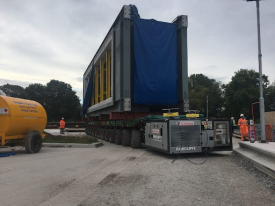
What is a self-propelled modular transporter?
A self-propelled modular transporter is a platform vehicle that features a large number of wheels and consists of different modules with an axle line count of four, five, six or eight.
Each module has its own engine and steering control system. A self-propelled modular transporter is perfect for transporting massive objects like oil refining sections, motors, large sections of bridges, and other items that are too big for a truck.
How do we use self-propelled modular transporters?
At JB Rawcliffe & Sons Ltd, we’re able to call upon 28 lines of SPMTs, that offer a capacity of over 1000 tonnes, for the movement of even the heaviest cargo.
Our SPMTs are ideally suited for a variety of trailer lengths and can be adapted to multiple widths to transport wide loads. This depends on the load capacity, dimensions and the scale of the project and, as a result, these adjustments make SPMTs perfect for operation in severe conditions.
Some of our SPMTs also feature a reduced height and compact design which makes them easier to operate in small spaces.
Arguably the best thing about SPMTs is that they can be coupled side to side and end to end, which enables us to carry even more cargo.
We can also operate remote units as single transporters. These mechanical steering trailers are controlled by electro-hydraulic motors and offer exceptional control, even in the tightest spaces.
Features of SPMTs
SPMTs have the highest load capacities in the world and can transport huge cargo. For this reason, they have transformed the construction of bridges. There are several other interesting features that SPMTs boast, such as:
- SPMTs can drive automatically without the tractor’s traction
- They can be customised in length and width to fit transportation requirements
- Each axle line is controlled independently
- Engineers control SPMTs via a computer or handheld device, while some have a driver cabin
What’s the difference between an SPMT and a modular trailer?
A modular trailer is a special platform trailer that features swing axles, steerable axles, and hydraulic suspensions. They’re used to transport oversized loads that are difficult to disassemble, but they are different to self-propelled modular transporters.
An SPMT is a platform vehicle that consists of wheels that drive and turn independently. It’s used on-site to transport huge, bulky items.
The main difference between an SPMT and a modular trailer is that the former is self-contained and the latter requires a tractor unit.
Why you should hire an SPMT from JB Rawcliffe & Sons Ltd
At JB Rawcliffe and Sons Ltd, we believe we’re one of the best and most dedicated companies at hauling large and heavy objects for all of our clients. For this reason alone, we think you should hire an SPMT from us.
However, there are plenty more reasons.
For a start, we’re capable of offering state-of-the-art equipment for all types of business transportation needs for clients throughout the UK, especially our self-propelled transporters.
Available in a wide range of width configurations to suit an especially large load, we can supply machinery to suit the scale of your company’s projects and your load dimensions, while ensuring the maximum possible safety and efficiency throughout.
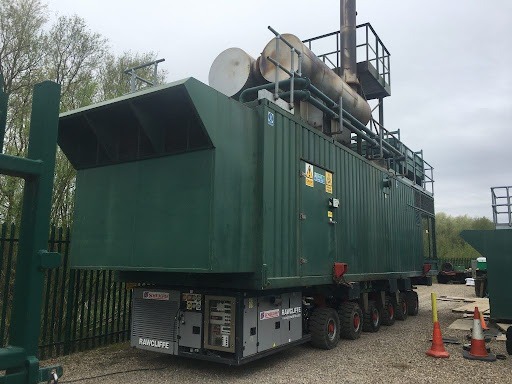
We also pride ourselves on offering a friendly, supportive and professional service to everybody who hires our equipment.
We work with a number of sectors to provide expert road transportation of fully-loaded haulage equipment so we’re confident that we’ll be able to help you with whatever your cargo needs are.
We’ll always take into account your needs before we offer a suitable solution for your high-load transportation needs.
Contact JB Rawcliffe & Sons Ltd to hire a self-propelled modular transporter
If you feel like your business needs the support of our heavy haulage self-propelled modular transporters, don’t hesitate to get in touch with us.
Discuss your requirements with our specialists by calling us on 01695 737 880. Alternatively, drop us an email at enquiries@jbrawcliffe.com, and we’ll get back to you as soon as possible.
